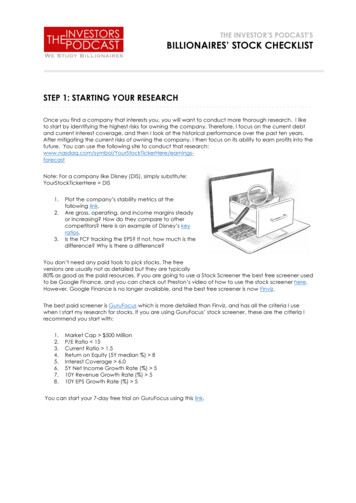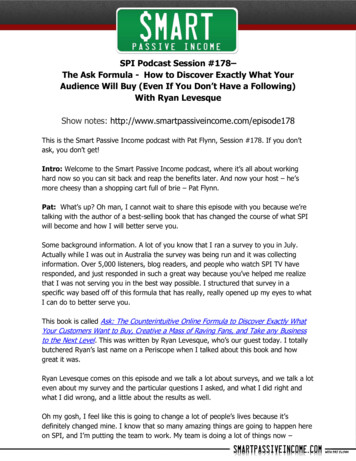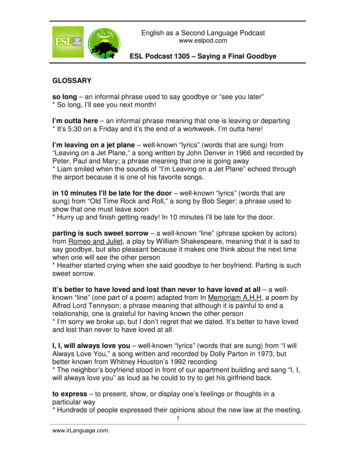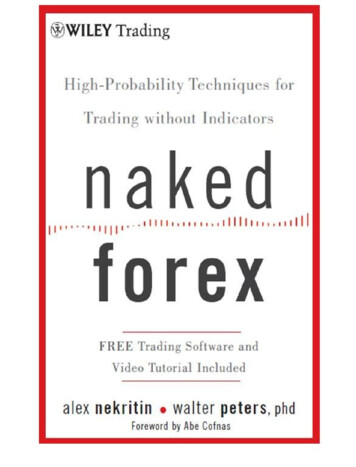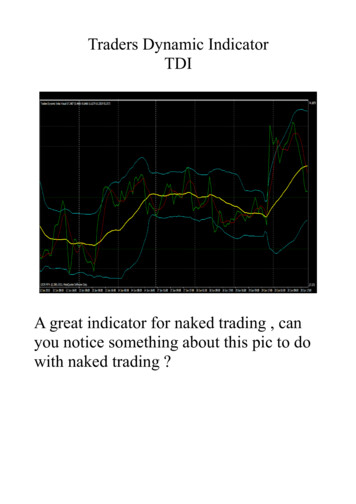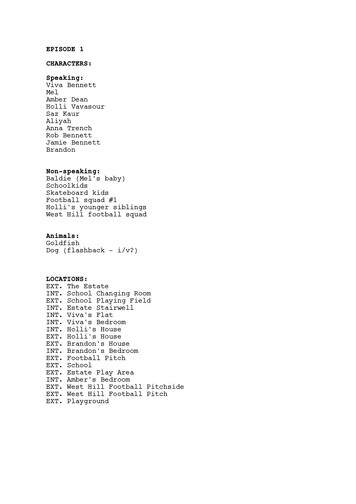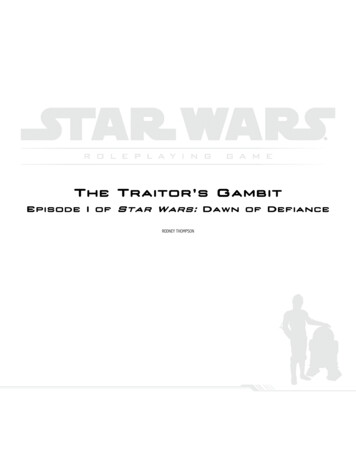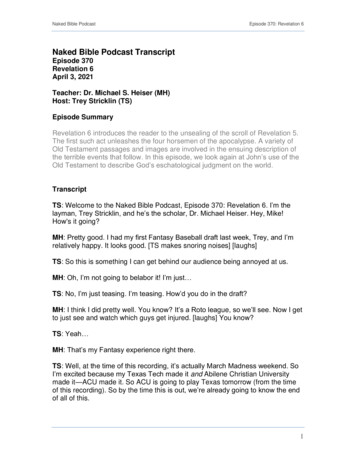
Transcription
Naked Bible PodcastEpisode 370: Revelation 6Naked Bible Podcast TranscriptEpisode 370Revelation 6April 3, 2021Teacher: Dr. Michael S. Heiser (MH)Host: Trey Stricklin (TS)Episode SummaryRevelation 6 introduces the reader to the unsealing of the scroll of Revelation 5.The first such act unleashes the four horsemen of the apocalypse. A variety ofOld Testament passages and images are involved in the ensuing description ofthe terrible events that follow. In this episode, we look again at John’s use of theOld Testament to describe God’s eschatological judgment on the world.TranscriptTS: Welcome to the Naked Bible Podcast, Episode 370: Revelation 6. I’m thelayman, Trey Stricklin, and he’s the scholar, Dr. Michael Heiser. Hey, Mike!How's it going?MH: Pretty good. I had my first Fantasy Baseball draft last week, Trey, and I’mrelatively happy. It looks good. [TS makes snoring noises] [laughs]TS: So this is something I can get behind our audience being annoyed at us.MH: Oh, I’m not going to belabor it! I’m just TS: No, I’m just teasing. I’m teasing. How’d you do in the draft?MH: I think I did pretty well. You know? It’s a Roto league, so we’ll see. Now I getto just see and watch which guys get injured. [laughs] You know?TS: Yeah MH: That’s my Fantasy experience right there.TS: Well, at the time of this recording, it’s actually March Madness weekend. SoI’m excited because my Texas Tech made it and Abilene Christian Universitymade it—ACU made it. So ACU is going to play Texas tomorrow (from the timeof this recording). So by the time this is out, we’re already going to know the endof all of this.1
Naked Bible PodcastEpisode 370: Revelation 6MH: I forgot all about that because I don’t watch basketball. But yeah. I don'teven know who’s supposed to win.TS: Gonzaga was number 1 overall.MH: Oh, really? Well, I’ve been on their campus once. So I guess I have aconnection, since they’re in the Northwest.TS: Oh yeah? What were you doing on their campus?MH: There was a regional SBL meeting on their campus one year. So I went outand gave a paper and did what you do at regional meetings: walk around andlisten to stuff.TS: That’s awesome.MH: So That’s my experience, you know? At least I was there. [laughs]TS: Yeah, that’s good stuff. We were talking about sports memorabilia before,and my son just turned 12 a few weeks ago, and my parents gave him anautographed Emmett Smith jersey. So I asked him, “Hey, do you want to keepthat in my office?” And of course, that didn’t go down well. But I didn’t getanything like that. We were talking. I didn’t get anything like that for my birthday.MH: Yeah. “Hey, Mom and Dad. Why did you waste your retirement [laughs] onyour grandson? You could’ve done that on me!”TS: Exactly. “I’m your son, and I don't get anything.” So I’m looking at anautographed Emmett Smith. We haven’t hung it up yet. So I’m looking at it. Andit’s giving me good vibes here. [MH laughs] Especially since we’re about to goand talk about the four horsemen here coming up.MH: Yeah, there you go. We’ll accept that as a segue. How’s that?TS: Okay.MH: That’s acceptable.TS: Okay, I’ll take it.MH: That’s a football reference and a Revelation reference. So TS: You’re welcome.MH: [laughs] Okay. And the good news, we should add, is that we’re actuallygoing to get through Revelation 6 in one episode! So there’s no two, three, four,2
Naked Bible PodcastEpisode 370: Revelation 6ad infinitum parts to this. And I judge these things by, “Okay, since the series isabout John’s Use of the Old Testament in Revelation, how much Old Testamentstuff’s going on the passage? Can I get through that in one pass or not?” Sothat’s how we judge these things. And in this case, yeah, we can. Some of thesethings are going to be familiar from chapter 5. But the new stuff put in here we’regoing to be able to do it. So I’m going to read to start off here the first eightverses (Revelation 6:1-8), and that’ll get us into what we need to do, at least asfar as our beginning point, just to refresh everybody’s memory.Now I watched when the Lamb opened one of the seven seals, and I heard oneof the four living creatures say with a voice like thunder, “Come!” 2 And Ilooked, and behold, a white horse! And its rider had a bow, and a crown wasgiven to him, and he came out conquering, and to conquer.3 Whenhe opened the second seal, I heard the second living creature say,“Come!” 4 And out came another horse, bright red. Its rider was permitted totake peace from the earth, so that people should slay one another, and he wasgiven a great sword.5 Whenhe opened the third seal, I heard the third living creature say, “Come!”And I looked, and behold, a black horse! And its rider had a pair of scales in hishand. 6 And I heard what seemed to be a voice in the midst of the four livingcreatures, saying, “A quart of wheat for a denarius, and three quarts of barleyfor a denarius, and do not harm the oil and wine!”5:007 Whenhe opened the fourth seal, I heard the voice of the fourth livingcreature say, “Come!” 8 And I looked, and behold, a pale horse! And its rider'sname was Death, and Hades followed him. And they were given authority overa fourth of the earth, to kill with sword and with famine and with pestilenceand by wild beasts of the earth.So that’s the first eight verses. Obviously, there are some familiar things here.We’ve got the Lamb. We’ve got the living creatures (these cherubim sort offigures from earlier in Revelation 4 and 5). We’ve got the reference to Death andHades (again, this is back in Revelation 1 and Revelation 3). So there are a fewfamiliar things here, but there’s going to be at least one case where we’re goingto note kind of a bit of a twist in what John is getting us to think about.But let’s just start with the obvious: “the Lamb opened one of the seals” in thefirst verse. Now Aune in his commentary observes something kind of obvious atthe beginning here. He says:3
Naked Bible PodcastEpisode 370: Revelation 6Since it is obviously very difficult to imagine a lamb opening a sealed scroll [MH:like how would he do that without fingers and thumbs?], It is possible that thefigure of the Lamb has subsequently been superimposed on an originallyanthropomorphic figure The group of four visions in 6:1–8 is structured by usingthe four cherubim, each of whom summons one of the four horsemen, whichafflict the world with a variety of plagues.Now this raises an interesting (but to be honest with you, it’s not terriblyimportant) point, about when John describes the Lamb, is he actually looking at alamb? Or is he using the word “lamb” to describe Jesus? Like “I looked and aLamb that was slain, and he’s standing before God.” This is Revelation 5language. I mean, it is possible (I would agree with Aune) that what John’sactually looking at is Jesus. But he uses the language of “the Lamb” becauseJohn does that elsewhere. If we have the same author here as in Gospel (and wesort of presume that), we have references to Jesus as the Lamb of God thattakes away the sin of the world. When John says that in John 1 at the Jordanthere while he’s baptizing, “Behold the Lamb of God which takes away the sin ofthe world,” okay, obviously he’s referencing to Jesus. And it’s equally as obviousit’s not a vision. I mean, that’s a real-time, boots-on-the-ground event. But it doescreate this question, especially when the “Lamb” is doing things that in this caserequire fingers and thumbs, at least you would think that that’s what’s going onhere. How else do you open a sealed scroll? Maybe the Lamb just looked at it?Who knows? We’re not told. But it at least opens the door, and commentatorshave gone back and forth, like, “Okay, what’s John actually looking at?” And as Ijust read in the Aune quote, maybe the figure of the Lamb has beensubsequently superimposed on an originally anthropomorphic figure. Theultimate answer is “who knows?” Because all we do have is the verbiage (thevocabulary). We have things that seem incongruent with the vocabulary. But hey,it’s an apocalyptic vision. Kind of like the way dreams don’t need to reallyconform to reality as we experience it. Alright. So an apocalyptic vision may notneed these sort of niceties either. But I thought I’d mention it because it is part ofthe discussion. Again, I don't think it’s terribly important either way. But just Werun into it right away.Now Beale, when he opens his discussion of the chapter, he writes this. It’ssimilar, but a few differences here:Rev. 6:1–8 is intended to show that Christ rules over such an apparently chaoticworld and that suffering does not occur indiscriminately or by chance.That’s actually going to be a fairly important thought. Because who holds thekeys to Death and Hades? That would be Jesus. That would be the risen Christ.Again, we’ve had that in a previous episode. So keep that in the back of yourmind, and we’ll get back to it. Beale writes:4
Naked Bible PodcastEpisode 370: Revelation 6This section reveals, in fact, that destructive events are brought about by Christfor both redemptive and judicial purposes The command for each of the fourdestructive horses and riders originates from the throne room, where Christ [MH:i.e., the Lamb] opens each seal. The cherubim around the throne issue commandsto the horseman in response to the opening of each seal. Only then do thehorsemen wreak their havoc.10:00So what Beale is doing here is he’s linking the release of the apocalypse to thecommand (by virtue of the opening of the seals) of the Lamb. Jesus is the onethat launches the war here. That’s the bottom line. Okay? We don’t often think ofJesus this way. We don’t think of the Lamb like this, frankly. And if you rememberback in chapter 5 when we talked about the Lamb, the imagery works two ways.We think of a lamb as being cute and harmless and skipping around in the field.We think of the ewe lamb from the parable with Nathan and David, and howpathetic that is, and so on and so forth. And the lamb was a sacrificial victim inOld Testament (Jewish) culture. But lamb imagery was also used of the gods andof rule, and of power, and of might. So there are two sides to the metaphor. Andhere very obviously we’re not seeing the passive victim side. We’re seeing theother side.Now other scholars have noted as they proceed through this that the mostobvious Old Testament source for these first eight verses is Zechariah 6:1–8. SoI’m going to read that. Because once I read through it, you’ll see that this iswhere the obvious points of connect are. Not the only ones, but this is the mostobvious. So Zechariah 6 begins this way:Again I lifted my eyes and saw, and behold, four chariots [MH: it’s not fourhorsemen; it’s four chariots] came out from between two mountains. And themountains were mountains of bronze. 2 The first chariot had red horses, thesecond black horses, 3 the third white horses, and the fourth chariot dappledhorses—all of them strong. 4 Then I answered and said to the angel who talkedwith me, “What are these, my lord?” 5 And the angel answered and said tome, “These are going out to the four winds of heaven, after presentingthemselves before the Lord of all the earth. 6 The chariot with the black horsesgoes toward the north country, the white ones go after them, and the dappledones go toward the south country.” 7 When the strong horses came out, theywere impatient to go and patrol the earth. And he said, “Go, patrol theearth.” So they patrolled the earth. 8 Then he cried to me, “Behold, those whogo toward the north country have set my Spirit at rest in the north country.”5
Naked Bible PodcastEpisode 370: Revelation 6So this is a bit more obscure (if I can use that word). I mean, how can anythingbe more obscure than the book of Revelation? Well, let’s try Zechariah on forsize. We’ve seen John repurpose passages in Zechariah already, and here he isagain. Virtually all Old Testament scholars acknowledge some relationshipbetween the four horses of Zechariah 6 (or the four chariots—teams of horses) So they’re going to look at those four chariot teams and they’re going to link themback to the teams of horses in Zechariah 1.So the steps go this way: “I’m reading Revelation 6. That takes my mind back toZechariah 6. And the precedent for Zechariah 6 was Zechariah 1, because thereare also chariot teams of horses there.” The problem is, well, all Old Testamentscholars are going to notice these things. And again, New Testament scholarsare going to notice these things too, because the references at least on thesurface are pretty obvious. The question is, “What’s the nature of the relationshipbetween Revelation 6, Zechariah 6, and of course, looping in Zechariah 1?” Andthat is hotly debated. Ultimately sort of aligning all three of these passages(Revelation 6, Zechariah 6, and Zechariah 1) is peripheral to what we’re doinghere on the podcast. You can read long sections (pages and pages and pages)of “How do we reconcile the colors precisely in Revelation 6 with the ones inZechariah 6? Does dappled mean grey?” All this sort of stuff. “How do we gofrom three chariot teams to four? And then to the four individual horses ” Look.For our purposes, we don’t really need to care about this. There are ways thatcommentators fix or resolve these issues. They fix these problems. If you wantthe mathematical resolution to these things and the color palette resolution tothese things, you can go consult a good exegetical commentary. I would think,though, for our purposes, some general conclusions are more relevant—moregermane. So I’m just going to give you four of them here.1. The scenes in Zechariah 1 and 6 include an angel figure that may be theAngel of Yahweh. We ran into this when we discussed Revelation 1:4. So wemight have the Angel of the Lord in Zechariah 1 and 6. We can’t be completelycertain that that’s the case, but you can make a case for it. And that’s going tomatter when we’re looking at Revelation here.2. In Revelation 6, the four horsemen are unleashed from God’s throne, which isan integral element of the Divine Council scene in Revelation 4-5. So let’s notlose sight of that.15:003. Third, the four horses correspond to the four corners of the earth. In otherwords, all the earth is under patrol or is going to be affected (in the case ofRevelation, negatively). All four corners of the earth. The whole earth is goingto There’s going to be an impact here. And again, back to the language ofZechariah 6, they’re patrolling. And there are commentators that Some of themwould see that as a neutral term. Others would say, “Well, they’re going out withmore purpose than that, and what John says about the purpose (these plagues—warfare and death) is not inconsistent with Zechariah 6.” Okay, wonderful. We’re6
Naked Bible PodcastEpisode 370: Revelation 6not going to drill down or we’d have three or four parts, just looking at each horseindividually. I don't want to spend an episode on a horse, four times. There areways to reconcile these things. But again, (1) we’ve got possibly the Angel of theLord, (2) we’ve got the Divine Council element with God’s throne, (3) we’ve gotthe whole earth (the four corners of the earth) affected by this.4. And fourthly, the horses in Zechariah are actually chariot teams. And thechariots in the Old Testament context were instruments of war, so I think it isarguable that the judgment idea is not absent in Zechariah. We’ll say that much.The chariot teams are sent out to punish the nations that are oppressing God’speople.So if you read Zechariah in context, what I’m suggesting is that because it’s achariot team, I’m going to be on the side of the commentators that say, “Youknow, if he was just going out for a look, he’d go single rider on a horse. If yousend a chariot, that implies something violent or it implies judgment, because thisis an instrument of war.” And in the context of Zechariah, that passage is aboutGod avenging his people—God punishing the nations that are oppressing God’speople. And that is very much in concert with the flavor of Revelation even at thispoint. Because haven’t we just read through the letters where God is basicallysaying (Jesus is saying), “Hey, endure to the end. And the Lord knows yoursuffering. The Lord knows those who are persecuting or oppressing you, and hewill not forget that. And they will have their day. The Lord is not going to let thispass without a judgment here.” And so this is unleashed in chapter 6. So thecontexts are actually more similar than you’d think.Now by analogy (just to summarize all of that), in Revelation 6, we have theLamb unleashing judgment on the world (the four corners—the whole world) bymeans of the four horsemen. And they are going to punish the world (i.e., thosewho are oppressing—persecuting—the ones who follow the Lamb). RememberRevelation 5, the martyrs that get the white robes? This is the context for this. It’svery much a Day of the Lord kind of feel to it. The Lord is going to avenge hisown.Now if the figure in Zechariah among the myrtles (back to Zechariah here) withthese chariot teams is in fact the Angel of Yahweh If that’s the case (and justgo back to where we talked about Revelation 1:4 and 1:5), then by analogy, thatwould align the Angel to Jesus. And of course, this is part of the Two Powersthinking (the Two Powers motif). But it’s not merely I’m bringing it up not tomake an ontological point. The Angel of Yahweh who is Yahweh That’s Jesus.So we’ve got Godhead language here. Okay, this is well-traversed territory forthis podcast. And of course, I spent a lot of time on the “God as man in the OldTestament” theme in Unseen Realm. But I want to make a different point, not anontological one.7
Naked Bible PodcastEpisode 370: Revelation 6The Angel of Yahweh did indeed wreak destruction on God’s enemies in the OldTestament. Let’s think about what the Angel does on occasion. For example, theAngel “with the drawn sword in his hand” (Joshua 5) to precipitate the conquest.Another example is the Angel of 1 Chronicles 21 that assaults Jerusalem. Inthose two scenes (Joshua 5, 1 Chronicles 21), the figure there (the Angel of theLord and the commander—the Captain of the Lord's Host) are the same entity.They’re the same figure. Again, I’ve spent a lot of time in Unseen Realm and inother books establishing why this is the case. And the key phrase is the drawnsword in the hand. That phrase is used only three times in Hebrew as it’s writtenin the Hebrew Bible. And the other two (besides Joshua 5) are absolutely clearAngel of the Lord passages. So we have a correlation here. And you have awarrior figure here. Now I’m going to quote a little bit that I wrote in the Angelsbook about this because this gets looped into other passages, including theDestroyer at Passover. So just bear with me here as I summarize some of thismaterial. I wrote in the Angels book:20:00It is clear from both passages [MH: Joshua 5 and 1 Chronicles 21] that the angel ofYahweh is in view and that he brings “destruction” [MH: mashḥı ̂t is the term usedin 1 Chronicles 21]. Interestingly, this is the identical term used to describe theangel of death in the account of the death of the firstborn on the eve of the firstPassover.I’m going to read Exodus 12:13, 21, 23:13Theblood shall be a sign for you, on the houses where you are. And when Isee the blood, I will pass over you, and no plague will befall you to destroŷ you, when I strike the land of Egypt.[mashḥıt]21ThenMoses called all the elders of Israel and said to them, “Go and selectlambs for yourselves according to your clans, and kill the Passover lamb.23Forthe LORD will pass through to strike the Egyptians, and when he sees theblood on the lintel and on the two doorposts, the LORD will pass over the door̂ to enter your houses to strike you.and will not allow the destroyer [mashḥıt](Exod 12:13, 21, 23)Continuing on with what I wrote in Angels:The mashḥı ̂t who was the angel of Yahweh in 1 Chronicles 21 and 2 Samuel 24 ishere distinguished from Yahweh by the line, “the LORD will pass over the door andwill not allow the destroyer [mashḥı ̂t] to enter your houses to strike you.” Yet we8
Naked Bible PodcastEpisode 370: Revelation 6read elsewhere [MH: in other passages] that it was Yahweh [MH: himself] whodestroyed the firstborn:Let me just stop there. If you look at this drawn sword, the mashḥı̂ t language, goback to Passover, “the LORD will pass over the door and not allow the destroyer[the mashḥı̂ t] to enter your houses.” So those are clearly two figures. But yet inother passages, Yahweh is the destroyer. So you have this blending, where thedestroyer is but isn’t Yahweh—this whole Two Powers thing going on. Here aresome of the passages that loop Yahweh into this:Psalm 105:26, 36:26 Hesent Moses, his servant,and Aaron, whom he had chosen.36 He struck down all the firstborn in their land,the firstfruits of all their strength.Psalm 135:5, 8:5 ForI know that the LORD is great,and that our Lord is above all gods.8 He it was who struck down the firstborn of Egypt,both of man and of beast;So the first passage there was Psalm 105:26, 36. “He [God] struck down all thefirstborn.” And the second one was, “He it was who struck down the firstborn ofEgypt.” Again, the divine name Yahweh is in that passage. That’s Psalm 135:5,8. There’s another one, Psalm 136:3, 10:3 Givethanks to the Lord of lords,for his steadfast love endures forever;10 to him who struck down the firstborn of Egypt,for his steadfast love endures forever;So it sure looks like Yahweh and the destroyer are one in the same, but yetthey’re different (this Two Powers thing). Some people have argued, though, thatPsalm 78:48–51 complicates this, that it gets in the way. And I’m going tosuggest that it really doesn’t. But I’m going to read the passage.48 Hegave over their cattle to the hailand their flocks to thunderbolts.9
Naked Bible PodcastEpisode 370: Revelation 649 Helet loose on them his burning anger,wrath, indignation, and distress,̂a company of destroying angels [MH: the Hebrew is malʾakê rāʿım].50 He made a path for his anger;he did not spare them from death,but gave their lives over to the plague.51 He struck down every firstborn in Egypt,the firstfruits of their strength in the tents of Ham.So some would say, “God didn’t do this destroying; it was this mashḥı̂ t who isn’tYahweh.” And people will deny the correlations and then assign the destructionto “a company of destroying angels” to get God off the hook here. Thecomplication is only surface level. In Angels I wrote:The ESV’s translation, “destroying angels,” is somewhat misleading with respect tothe terminology we are attempting to trace. The Hebrew term translated“destroying” is not the word mashḥı ̂t associated with the destroyer in thepassages we saw earlier. We should also observe that Psalm 78:49 does not saythe “destroying angels” killed the firstborn [MH: it never actually says that]. Thatact is, once again, attributed to Yahweh (v. 51) [MH: of Psalm 78]. Yahweh mayhave sent angels to enact the other plagues, but the death of the firstborn isattributed to him [MH: and, of course, to the mashḥı ̂t, who is the Angel of theLord]. These angels [MH: the group of angels] do not act in the role of thedestroyer.25:00That is the single figure who is also Yahweh. Now the point to be taken here Why am I bringing all this up? Again, it’s Old Testament context for what we readin Revelation 6. Because here it is not Yahweh or the Angel Is it or isn’t it theAngel of the Lord? I mean, it’s the risen Christ. But if you’re going back toZechariah for the parallel, if indeed that is the Angel of the Lord (i.e., thedestroyer), that would make a lot of sense. Because look what the Lamb does inRevelation 6. He unleashes death and plagues and all this sort of stuff. It’s kindof interesting if you (and we’ll do this in a subsequent episode) start to thinkabout the use of the “plague” imagery for what happens on earth in Revelation.Because at one point you have the Passover lamb slain and the Angel of theLord is the one destroying the firstborn. And now as Revelation progresses—asthe salvation plan of God progresses—you have the Lamb now who is Christ,who is also the destroyer. I mean, it’s a reversal. It’s a folding back of theelements. And now instead of the people of God having to duck the plagueshere, it’s still God (now it’s the risen Christ) unleashing all this on the enemies ofthe people of God and so on and so forth. So there’s a parallel, but yet there’salso this reversal unfolding of certain of the elements. It’s kind of interesting.10
Naked Bible PodcastEpisode 370: Revelation 6But anyway, the point for today to be taken here is that in Revelation 6, the slotthat would be reserved for either Yahweh or the destroyer (the destroying angel,who is the Angel of the Lord) is Jesus. The language here is Day of the Lordjudgment. And Jesus is not the gentle savior. He is the destroying judge. And thisisn’t commonly the way we think about Jesus. Let’s just be honest. We often donot put this When we think Christology, we don’t think of this. [laughs] But thisis part of Christology. I’m not going to rabbit trail too much, but if you’reinterested, I have put an article in the protected folder. Tremper Longman, whowas an Old Testament prof for many years at Westminster Seminary (now he’sat, I think it’s Westmont in California). Tremper Longman’s article is titled “TheDivine Warrior: the New Testament Use of an Old Testament Motif." It’sin Westminster Theological Journal back in 1982. It’s a really good articlebecause it shows how the New Testament portrayal of Jesus is not just a passivesuffering servant—the Lamb, the sacrificial victim. There are a lot of passages(and it’s not just Revelation 6) that use divine warrior imagery of the risen Christ.And some of it’s even before you get to Acts and beyond. I mean, there are hintsof it. So it’s just very interesting. But this is part of Christology. Here in Revelation6 we don’t have the gentle savior; we have the destroying judge. It’s the sameperson.Now another issue that arises from the opening of the scroll by the Lamb iswhether the plagues represented by the four horsemen are sequential orsimultaneous. And this (for me, anyway) was interesting enough to park on a littlebit, because we assume that And popular prophecy talk So let’s drift overinto that a little bit. We assume a sequence of plagues. (This one followed by thisone followed by this one followed by this one.) But there’s actually an issue withthat. So Beale summarizes the issue or the problem. And he writes:The visionary sequence of the four seals being opened could represent thesequential occurrence of each disaster, one after another. But more probably thedisasters are simultaneous. This is suggested in that (1) the fourth sealsummarizes the prior three (see below on 6:8); (2) the models of Ezek. 14:12–13;Zech. 6:5–8; and the Synoptic [MH: Gospel] eschatological discourse, on whichRev. 6:1–8 is based, portray events of tribulation occurring simultaneously;indeed, the Synoptic parallels, though fairly uniform, even have differentsequences of the trials from Rev. 6:1–11; (3) the glorified saints in Rev. 6:9–11[MH: we haven’t gotten there yet, but we’ll just loop this in] appear to havesuffered under all four trials portrayed in the seals. Nevertheless, a logical patternrepeatable throughout the age is discernible: conquest (the first rider), togetherwith civil unrest (especially for persecuted Christians—the second rider), leads tofamine (the third rider) and death (the fourth rider) Ezek. 14:12–23 is alsoformative for this section [MH: we’ll get to that momentarily] (cf. Deut. 32:23–25). Ezek. 14:21 is explicitly quoted in Rev. 6:8b, where it functions as a generalsummary of the preceding trials of conquest, sword, and famine, the first two of11
Naked Bible Podcast30:00Episode 370: Revelation 6which include “death.” This quotation of Ezekiel also adds one more trial:affliction by beasts. The quoted words have the same function in Ezek. 14:21,where they clearly sum up the four preceding statements about trials as “four eviljudgments.” These punishments come on nations in general when they areunfaithful to God. The trials there are listed respectively as lack of bread and“famine” (14:13), “wild beasts” (14:15), “sword” (14:17), and “death” (14:19). Thepoint of Ezek. 14:21 is that all Israelites will suffer persecution because oframpant idolatry (cf. 14:3–11). The purpose of the trials is to punish the majorityof the nation because of its sin and simultaneously to purify the righteousremnant by testing their faith (cf. 14:14, 16, 18, 20, 22–23).Now the point here is that Let’s think about this. When we talked about thescroll itself, we actually did get into this a little bit. And that is, the scroll hasseven seals. Just think of a scroll, sealed seven times. If you open the first four,you still can’t read the scroll. So this notion of, you open one seal and now youcan read it, what happens? It mars the linear succession idea. And so whatBeale is arguing We talked about that last time, but he’s also bringing it uphere. The linear idea of the judgments isn’t really a good one, because you havethe fourth summarizing the previous three. You’ve got the synoptic Gospels.They don’t always have the same order. Sometimes there are these summarystatements that occur simultaneously. In other words, you may have to wait till allthe seals are open for all of this stuff to explode. It’s not typically the way wethink. And certain eschatological systems (certain End Times systems) actuallysort of depend on sequencing. So that’s all I’ll say there. And it’s not really agreat argument. So let’s go into Revelation 6:9-11. I’ll read that:9 When[the Lamb] opened the fifth seal, I saw under the altar the souls ofthose who had been slain for the word of God and for the witness they hadborne. 10 They cried out with a loud voice, “O Sove
creature say, “ome!” 8 And I looked, and behold, a pale horse! And its rider's name was Death, and Hades followed him. And they were given authority over a fourth of the earth, to kill with sword an
